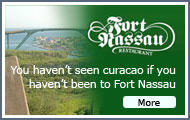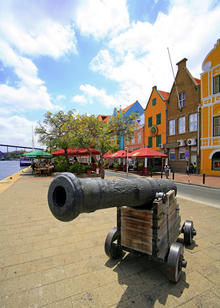Forts
From the capture of Curaçao in 1634 until the end of World War II, the Dutch never felt completely safe on the island. At first they were threatened by Spain, then by France and England and, finally, in the 20th century, by Venezuela and Germany. For centuries, the island also had to contend with privateers and pirates. In 1713 the French privateer Jacques Cassard appeared before the island, bringing his naval force. It was only after payment of a gigantic ransom of 400,000 guilders that the governor succeeded in avoiding looting. No wonder the Dutch were anxious to build a fort at each vulnerable spot on the island. None of these Curacao forts could withstand a large-scale attack, but they were very effective against privateers and pirates. Eight of the forts have survived time, wholly or partially. The town wall that used to surround the old center of Punda was almost completely demolished a century ago. Six of the best preserved forts are described below. Some have been put to use in ways suiting today's way of life. Some have become hotels, shops, and restaurants. Others were transformed into museums or professional offices. All of them contribute to the preservation of Curaçao's long, full history.
FortAmsterdam
Origin - Strategically built on the point (Punda) of the eastern finger of land at the harbor entrance. Fort Amsterdam was named after the Chamber of Amsterdam, a department of the Netherlands West Indies Co, which was in charge of the administration of Curaçao. This fort was built in 1635.
Points of interest - Fort Amsterdam was the most important of Curaçao's eight forts, and is included in UNESCO's list of World Heritage sites. Embedded in its southwest wall is a cannonball fired by Captain Bligh's troops.
What you'll find there - The Governor's residence, the Ministry, several government offices, and the United Protestant Church, which includes a museum.
FortBeekenburg
Origin - Built in 1703 at the Caracas Bay, which covered the "Spanish Waters" inner Bay. Named after Director van Beek, who planned the city's defense from 1701 to 1704.
Points of interest - The fort had to ward off pirates as well as the French and English fleets more than once during the 18th century. Fort Beekenburg is one of the best-preserved forts in the entire Caribbean.
What you'll find there - The fort is built at the Caracas Bay, where you can visit the beach, rent water sports equipment and visit the fort (Entrance fee charged).
FortNassau
Origin - Named after the Royal House of Orange. Built in 1797 to defend both the St. Anna Bay as well as part of the city of Willemstad.
Points of interest - Fort Nassau has been preserved very close to its original state, and for years has served as a harbor signal and control tower, regulating the opening and closing of the Pontoon Bridge.
What you'll find there - A restaurant serving international cuisine.
FortWaakzaamheid
Origin - This smaller fort, with its view over Otrobanda, was built in 1803 to defend the island against a French invasion.
Points of interest - In 1804, it fell victim to a 26-day siege by Captain Bligh of "Mutiny on the Bounty" fame. During World War II, the Americans mounted guns on the walls, and established barracks and an observation post.
What you'll find there - A restaurant serving international cuisine.
Riffort
Origin - Built in 1828 between the harbor entrance, sea coast and the former Rifwater, the Rif Fort was meant to defend the outer section of Willemstad's Otrobanda district.
Points of interest - Riffort has housed the Authority, Public Works, the police, and the Boy Scouts.
What you'll find there - Riffort Village, a shopping center, several restaurants, several bars, an ice-cream & coffee shop and a terrace overlooking the harbor.
Waterfort
Origin - Built in 1634 to defend the outer section of Willemstad's Punda district.
Points of interest - The original structure was replaced in 1827 by an imposing building with 136 turrets and vaults containing stores, stables, and medical services. Accommodated numerous troops during World War II-featured coastal and anti-aircraft artillery mounted on the walls.
What you'll find there - A variety of restaurants and terraces overlooking the sea.
Escape to the Caribbean’s hidden treasure. Fall in love with Curacao’s world-class diving and beaches, invigorating outdoor adventure, and welcoming culture. Make your Curacao Caribbean travel arrangements today!





